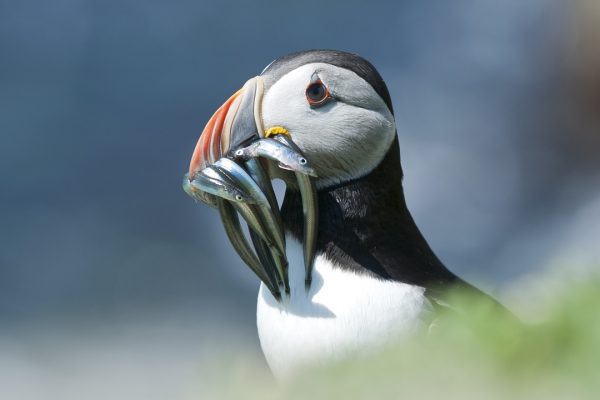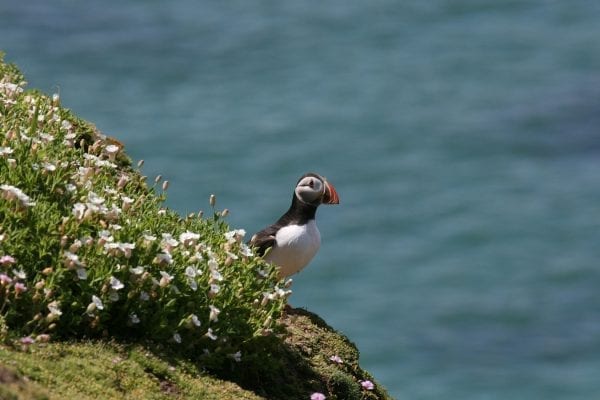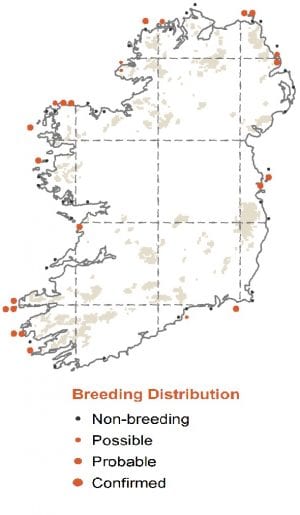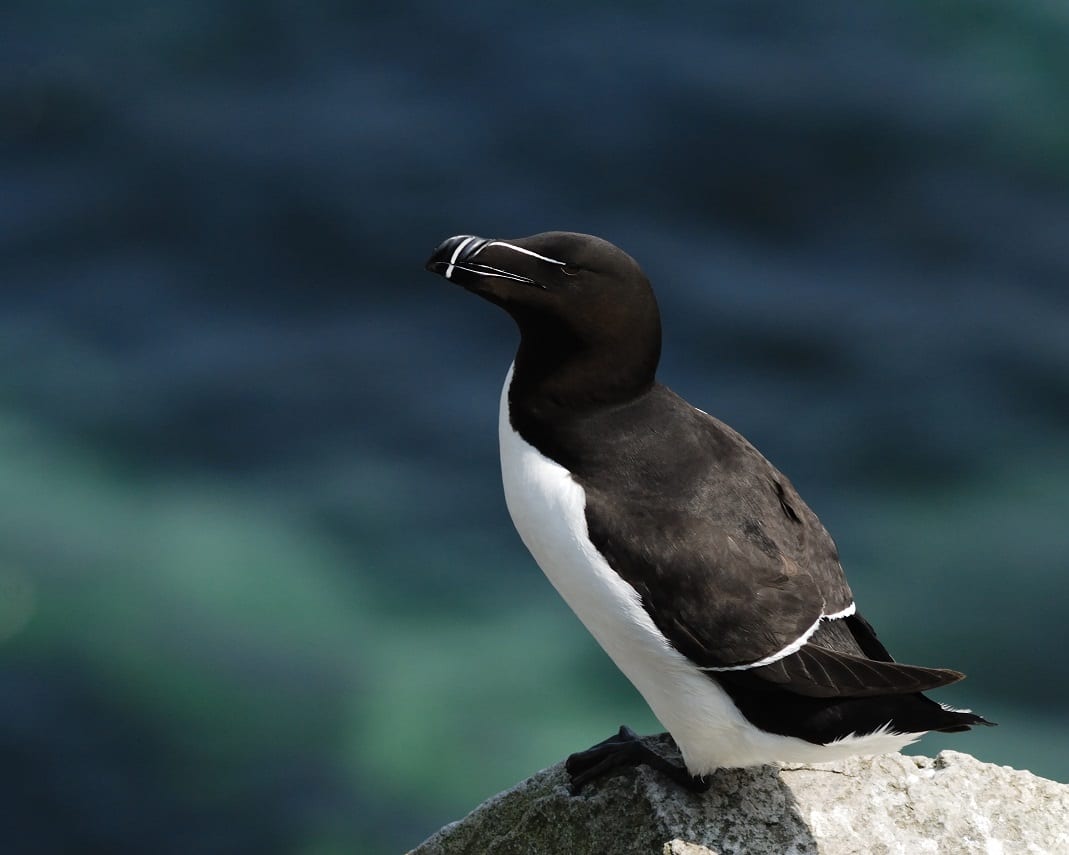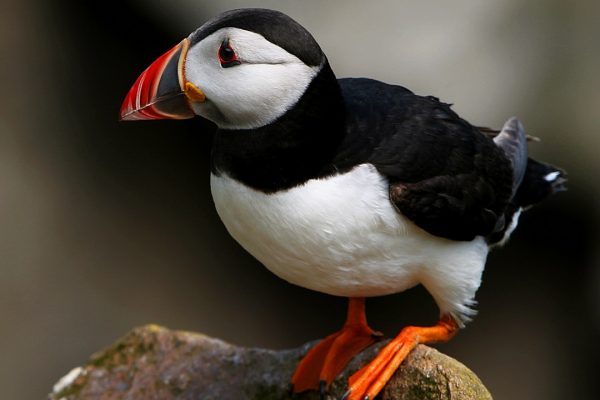
Puffin
| Irish Name: | Puifín |
| Scientific name: | Fratercula arctica |
| Bird Family: | Auks |
red
Conservation status
Conservation status
Status
Summer visitor from March to September to sea stacks and cliffs, mainly along the west coast of Ireland.
Identification
The smallest species of Auk in Ireland, a highly marine species which is only found on land in the breeding season. A black and white seabird, with black above and white below. In the breeding season the parrot like multi-coloured bill and large white patch on the face make adults distinctive and easily recognisable at close quarters. The bill is smaller on the adult in winter and much smaller on the juvenile. At a distance can be told from Guillemot by its small size, thicker body, larger, heavier head and darker underwing.
Voice
Deep grunting, mainly from the burrow.
Diet
Marine fish and crustaceans.
Breeding
Attends colonies from April and early August. Nests in colonies in burrows, or sometimes in boulder screes and in cracks in steep cliffs, rather like Razorbills and Black Guillemots. Will utilize rabbit burrows and will evict rabbits. Usually nests in areas that are safe from mammalian predators, for which reason it prefers off- shore islands.
Wintering
Winters far out to sea and not often seen outside of the breeding season.
Monitored by
Breeding seabirds are monitored through seabird surveys carried out every 15-20 years.
Blog posts about this bird
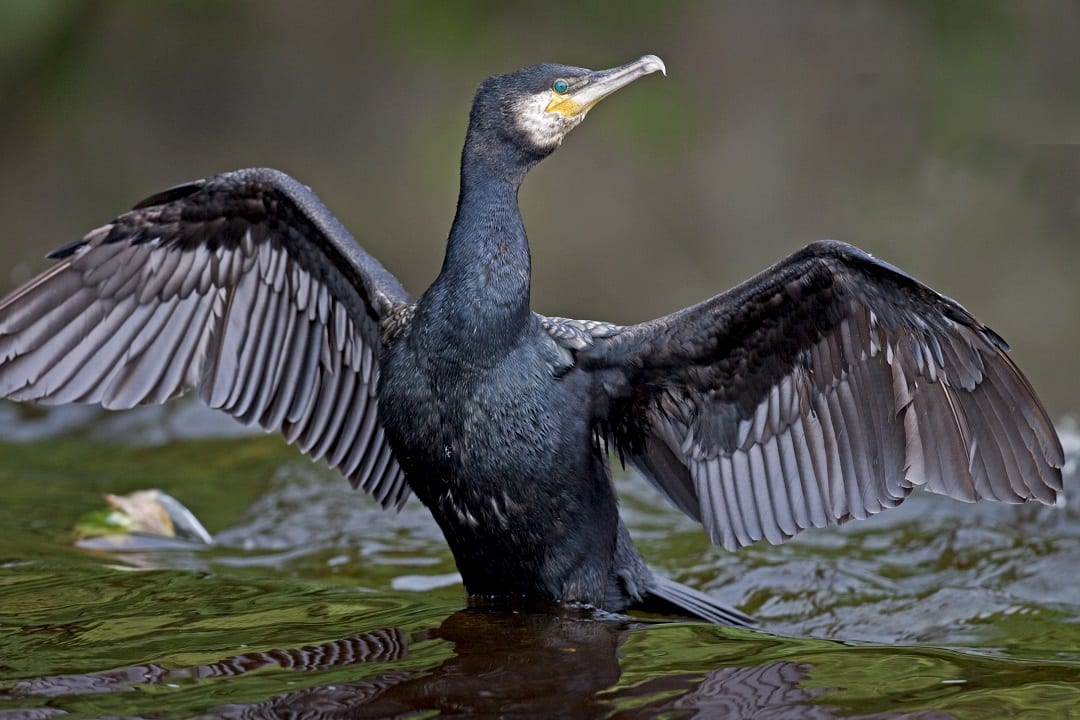
Seabirds of Europe: Report highlights declines and potential solutions
BirdLife International launched a report Seabirds of Europe: Current status, main threats and way forward this summer.
The report finds that over a third of seabirds (38%) in Europe have decreasing trends. One in three species are threatened with extinction according to the latest EU and European IUCN Red List assessments (2020 and 2021 respectively).
Among the most threatened European seabird species are the endemic Balearic Shearwater and the Zino’s Petrel, and species like the Atlantic Puffin are also singled out for their worryingly declining trends. By 2050, the Atlantic Puffin population is projected to decline by 89% across Britain and Ireland.
The seabird groups affected by the most threats overall are terns, medium-sized gulls, Grebes, Cormorants and Loons.


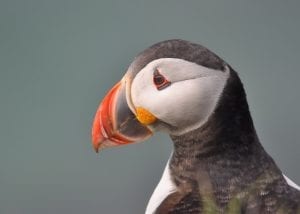
Photo: Puffin. Rónán McLaughlin
What is driving the decline of seabirds? Overfishing, invasive alien species and climate change are the main drivers of decline among seabirds during the breeding season. Climate change impacts, including temperature rise and severe stormy weather, cause increasing harm to seabirds. Other reasons for declines in the EU region include overfishing, hunting, pollution, energy infrastructure, recreational activities, and avian influenza. As the list of threats demonstrates, most seabirds are not just affected by one threat throughout their life cycle, but by multiple threats. The cumulative impact of all these threats therefore needs to be considered when assessing the pressures these animals face and the solutions to holistically conserve them. As part of their lifecycle, seabirds spend time both on land and at sea, and they face some threats only during certain seasons. Threats occurring on land will predominantly affect seabirds during the breeding season, whereas marine threats may affect seabirds throughout the entire year. In Europe, threats occurring in the marine environment have a higher impact on seabirds than threats occurring on land. Pressures from Invasive Alien Species (e.g. predation by rats) is an example of a threat that occurs on land and mostly during the breeding season. Invasives can negatively impact the breeding success of seabird populations, especially on chick survival and egg hatching. Recreational activities are a constant pressure during the entire year for coastal species, such as gulls and terns. For example, beach tourism can cause disturbance to birds as they use extra energy to find new resting and nesting places.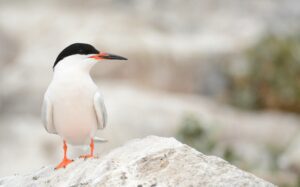
Photo: Roseate Tern. Brian Burke.
Finding solutions Political leaders and decisionmakers already have the solutions to protect vulnerable seabirds, marine species and habitats. The report takes a deep dive into some of them, including:- Eradicating and controlling invasive species
- Reducing bycatch through different types of fishing gear
- Fully implementing the EU Common Fisheries Policy to tackle overfishing
- Establishing Marine Protected Areas (MPAs)
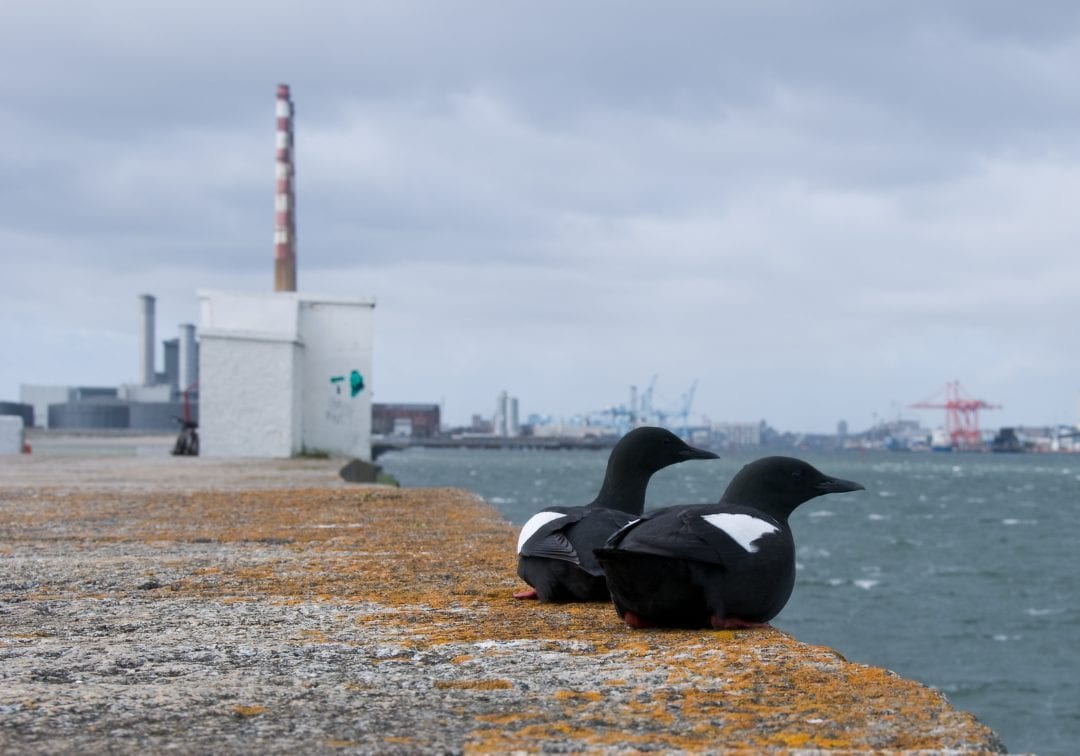
Embracing our maritime heritage this National Heritage Week
National Heritage Week takes place from 17th-25th August 2024. National Heritage Week celebrates Ireland’s cultural, built and natural heritage, uniting communities, cultural institutions, academics and organisations to build awareness about the value of heritage and support its conservation.
By Rosalind Skillen
Over the years, National Heritage Week has grown to become an island-wide event celebrating all aspects of our built, natural and cultural heritage.
It may be surprising to learn that policy related to the marine environment and foreshore section sits in the Department of Housing, Local Government and Heritage – not the Department of Environment, Climate and Communications, as some may assume. This reflects the fact that, as an island nation, our history and heritage have been shaped by the sea and Irish rivers, lakes, and wetlands.
It is also one of the primary reasons why the nine day-long National Heritage Week now includes a Water Heritage Day, held in partnership with the Local Authority Waters Programme. Water Heritage Day is happening on Sunday 25th August 2024 and the day celebrates water throughout Ireland, its history, heritage and our connections with it. It also gives us the opportunity to reflect on the importance of water to our daily lives and consider what more we can do to conserve this valuable resource.
The theme of this year’s National Heritage Week is “Connections, Routes and Networks”, inviting us to explore the ways we are connected to each other through physical or cultural connections.
When we think about the relationship between these three strands – heritage, the sea, and connection – there are several dimensions to this relationship. The sea connects us to the natural world. It also connects people, places, cultures and economies. It is a site of trade and transportation, an issue of mutual benefit and cooperation, and a home for many diverse ecosystems that are bound together in a complex web of ecological interdependence.
Take the Atlantic Ocean off the west coast of Ireland. To take the 2024 theme of “Connections, Routes and Networks”, the waters in the Atlantic transported millions of Irish emigrants to the New World in one of the most tragic periods of Ireland’s history. Where sea meets shore, the Atlantic is renowned for its stunning and rugged coastline, its deep maritime heritage, strong history of fishing, and its variable and windy weather. This is one of the most important coastlines for seabirds, with Galway Bay and surrounding islands hosting some of the largest aggregations of Kittiwake, an internationally important breeding population of Guillemot, as well as important colonies for Puffin, Razorbill and Fulmar. Further north in Mayo, the coastline contains breeding sites for Terns, Auks and Fulmar.
Covering 1/5 of the Earth’s surface, the Atlantic is not only part of Irish heritage but is also a connector. The Atlantic not only connects two continents and serves as a network for global trade, but it also is a route used by seabirds from the UK, Ireland and the US. Seabirds from all 3 nations use the Atlantic as a migration route for breeding and feeding, and there is data showing that US and Irish birds use one of our most important MPAs (NACES) nestled in the heart of the North Atlantic Ocean. In 2021, OSPAR designated NACES as an MPA following research led by BirdLife International, which used tracking data from 21 species of seabirds across 56 colonies. This tracking data revealed that 5 million birds, including Puffins that breed on Skellig Michael, use the NACES MPA every year, making the site a seabird hotspot. A “connector” in the truest sense, the site is one of the most significant congregations of migratory seabirds in the Atlantic.
Conclusion
As the summer draws to a close, with many looking forward to a new routine or the return of school, National Heritage Week offers an opportunity to look back and to appreciate our coasts, seaports and vast maritime area.
Crucially, protecting the marine environment will be vital to preserving our rich Irish heritage for future generations. At the time of writing, we are still waiting for the publication of national Marine Protected Area (MPA) Bill, a vital piece of legislation that would see 30% of Ireland’s water designated as MPAs by 2030, including 10% strictly protected. The MPA Bill was promised in the Programme for Government (2020), and multiple Government announcements and speeches thereafter. We need robust marine protection and effective management of Irish waters to protect the rich maritime heritage that we enjoy across Ireland, and to preserve it for more generations to come.
Find out more about Fair Seas campaign to protect 30% Irish seas by 2030:
FairSeas | Building a Movement of Ocean Stewardship
Find out more about events taking place during National Heritage Week:
Home | National Heritage Week 17th – 25th August 2024

